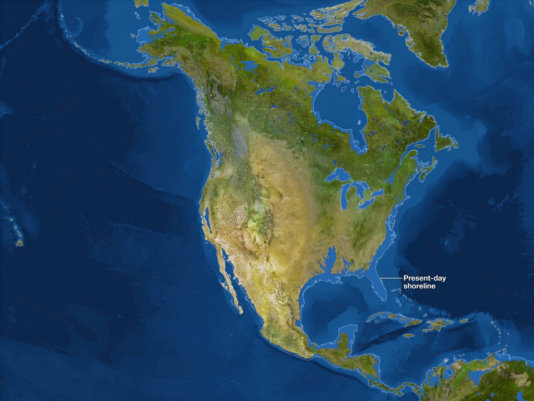- About
- Topics
- Picks
- Audio
- Story
- In-Depth
- Opinion
- News
- Donate
- Signup for our newsletterOur Editors' Best Picks.Send
Read, Debate: Engage.
| November 13, 2013 | |
|---|---|
| tags: | #climate change, #National Geographic, #sea levels |
| located: | United Kingdom, USA, Italy |
| by: | Itai Lahat |
Although it offers a vision of Earth some 5000 years into the future, this image from National Geographic depicts a dreadful picture of man-driven destruction - a picture in which melted polar ice has created a sea level rise of some 65 metres.
“The maps here show the world as it is now, with only one difference: All the ice on land has melted and drained into the sea, raising it 65 meters and creating new shorelines for our continents and inland seas. There are more than 20 million cubic kilometres of ice on Earth, and some scientists say it would take more than 5,000 years to melt it all. If we continue adding carbon to the atmosphere, we’ll very likely create an ice-free planet, with an average temperature of perhaps 26 degrees Celsius instead of the current 14.5”.
Of course, it's not necessary for all of the ice to melt for us to experience devastating effects of sea level rise. Just from the current sea level rise caused by melting ice and thermal expansion, we're already seeing destruction from higher water. Right now, Alaskan villages are worrying about what to do as melting ice threatens to erode their village out from underneath their feet. In the Pacific, low-lying islands face existential questions such as if a country is underwater, is it still a nation-state?
With Arctic temperatures at their highest in 44,000 years, ice cover has hit record lows and scientists report that sea level is rising 60% faster than anticipated. Just 1.8 metres of sea level rise would be enough to ruin South Florida and experts warn that we've already "baked in" approximately 21 meter of sea level rise.
So what will Europe look like? London? A memory. Venice? Reclaimed by the Adriatic Sea. Years from now, in this catastrophic scenario, the Netherlands will have long since surrendered to the sea, and most of Denmark will be gone too. Meanwhile, the Mediterranean's expanding waters will also have swelled the Black and Caspian Seas. Happy times ahead? Take a look at the interactive map and find out for yourself.
By copying the embed code below, you agree to adhere to our republishing guidelines.

